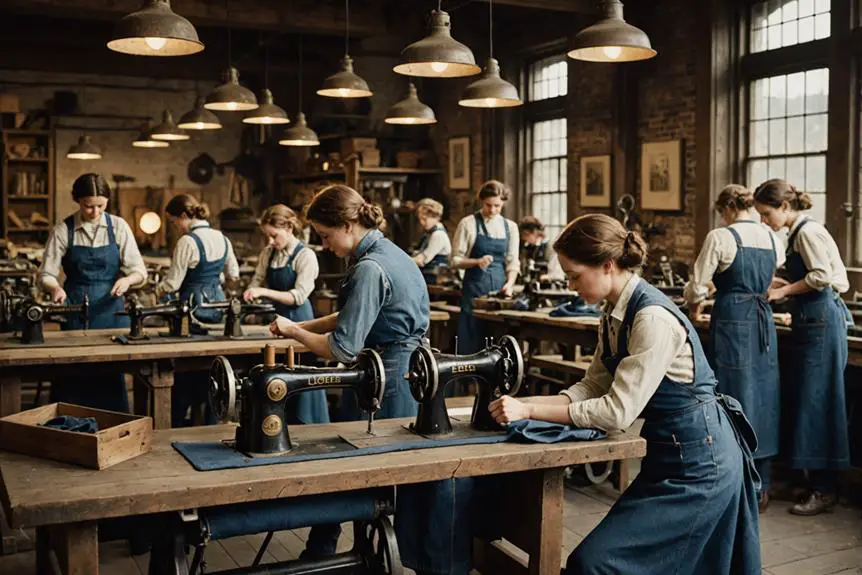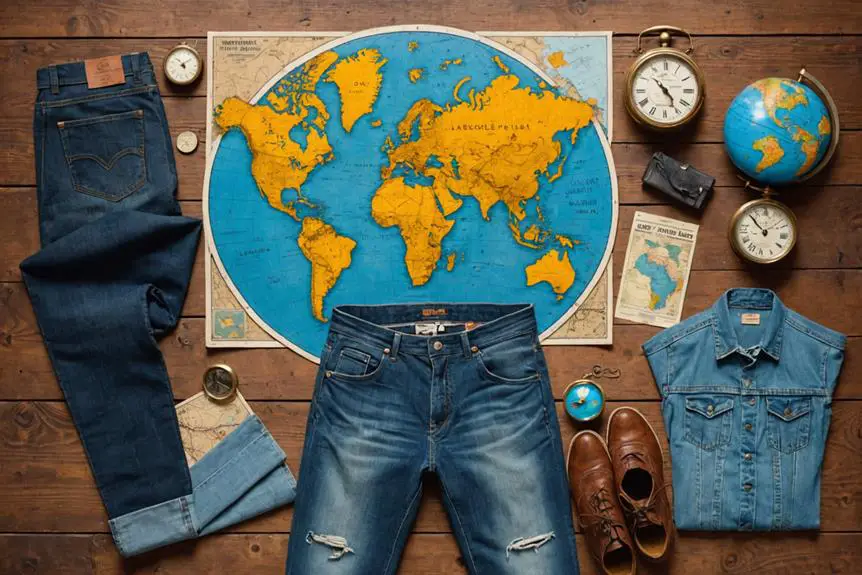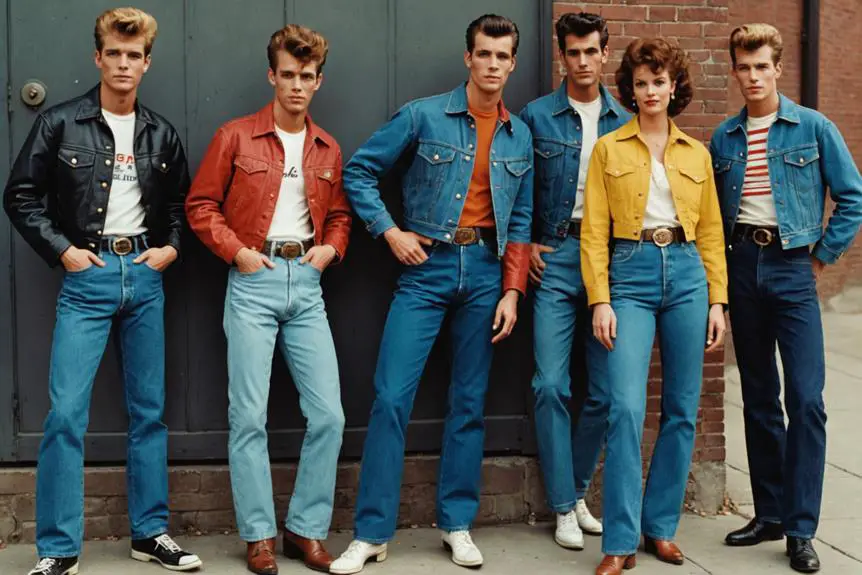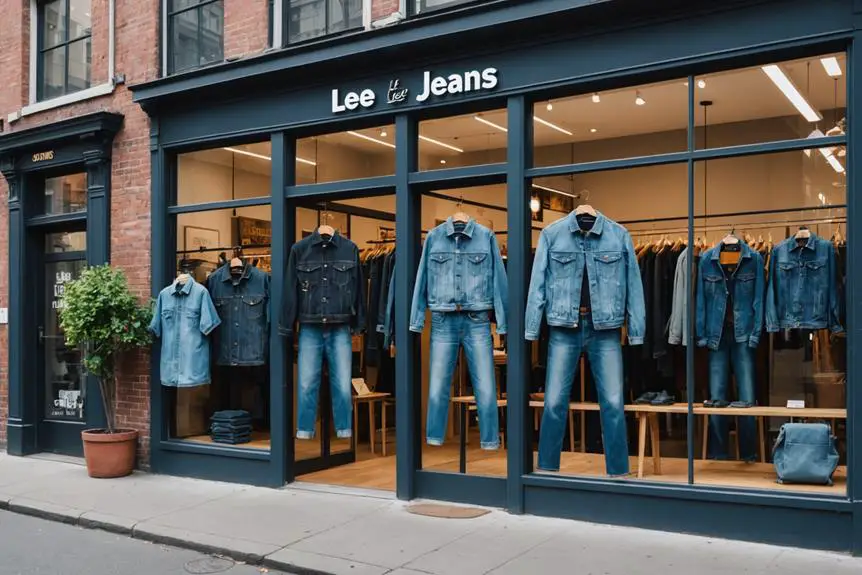Lee Jeans, a renowned fashion brand, traces its origins back to 1889 when Henry David Lee transitioned from grocery distribution to the world of clothing in Kansas. The brand quickly gained recognition for its innovative designs, such as the 1911 Lee Bib Overall and the 1926 zip-fly 101Z, which set new standards in denim fashion. By the 1950s, cultural icons like James Dean played a pivotal role in transforming denim from a utilitarian workwear staple to a fashionable statement, all while preserving its practical roots.
As the brand expanded, Lee Jeans ventured into global markets, embracing sustainability in its manufacturing processes to appeal to the environmentally conscious consumer. Today, modern collections like Extreme Motion demonstrate Lee's commitment to innovation and adaptability in response to evolving consumer preferences. This unique blend of rich heritage and contemporary design solidifies Lee Jeans' position in the fashion industry, inviting enthusiasts to explore its remarkable journey further.
Origins of Lee Jeans

The origins of Lee Jeans trace back to 1889, when Henry David Lee established the H.D. Lee Mercantile Company in Salina, Kansas. Initially focused on grocery distribution, the Company soon pivoted to clothing manufacturing, sensing a burgeoning demand for durable workwear. Lee's first notable product, the Lee Bib Overall, launched in 1911, set the stage for the brand's future success in the workwear market by combining functionality with comfort.
As the industrial landscape evolved, so did Lee's offerings. In 1913, the introduction of the Lee Union-All—a one-piece coverall—catered specifically to mechanics and solidified Lee's reputation as a reliable choice for work wear. This innovation not only showcased the Company's commitment to quality but also highlighted its understanding of the needs of laborers.
Early Innovations in Workwear
Building on its early successes, Lee Jeans continued to innovate in workwear, responding to the evolving needs of laborers in the early 20th century. One of their most significant achievements was the introduction of Union-Alls in 1913, a revolutionary one-piece coverall designed at the request of a mechanic seeking better protection. This effective solution quickly gained traction, and by 1916, it became a staple among auto mechanics.
To accommodate the growing demand, Lee expanded its manufacturing plants in critical locations between 1915 and 1919. Importantly, 1926 saw the launch of the 101Z, the first jean with a zip fly, showcasing Lee's commitment to innovation in denim design. Additionally, the rollout of Jelt Denim in the 1920s enhanced durability and comfort, solidifying Lee's reputation in the workwear business.
Key innovations include:
- Union-Alls: The first one-piece coverall for mechanics.
- Expansion of manufacturing plants: New facilities in Kansas City, South Bend, Trenton, and Minneapolis.
- 101Z zip fly: A groundbreaking design in denim.
- Jelt Denim: A material that boosted durability and comfort.
These advancements illustrate Lee's proactive approach to meeting laborers' needs.
Iconic Branding and Mascot

Lee Jeans carved out a unique identity in the competitive landscape of workwear through its innovative branding, most importantly with the introduction of the Buddy Lee doll in 1920. As the brand's mascot, Buddy became one of the earliest characters in American advertising, playing a pivotal role in promoting products from the Lee Mercantile Company. Through various advertising campaigns, the Buddy Lee dolls showcased the toughness and durability of Lee's workwear, resonating with consumers who valued reliability.
By 1962, Buddy Lee had become the second biggest selling toy in the United States, a proof of his significant impact on brand recognition. The doll's cheeky grin and shifty eyes contributed to a distinctive brand identity that has endured over the decades. In the late 1990s, the Lee Mercantile Company resurrected Buddy Lee for new advertising campaigns aimed at youth, striking a balance between nostalgia and modern marketing.
This clever integration of iconic branding not only maintained the legacy of Buddy Lee but also guaranteed that Lee Jeans remained relevant in an evolving marketplace. Ultimately, the Buddy character embodies the spirit and resilience of the Lee brand.
Cultural Impact in Fashion
Buddy Lee's influence extended beyond mere branding; it played a significant role in shaping the cultural landscape of fashion. In the 1950s, Lee jeans became synonymous with icons like James Dean and Marilyn Monroe, helping to normalize denim as everyday casual wear. This shift was monumental, marking denim's evolution from utilitarian workwear to a staple in popular culture.
Key factors contributing to this cultural impact include:
- Innovative Design: The Lee 101Z, introduced in 1926, showcased Lee's commitment to innovation, featuring the first zip-fly jeans.
- Cultural Symbolism: Buddy Lee, introduced in the 1920s, became a recognizable figure, enhancing brand relevance and cultural connection.
- Western Heritage: The Lee Westerners line in the 1960s linked Lee jeans to cowboy culture, embedding them deeper into American identity.
- Targeted Marketing: In the 1970s, Lee's focus on high school and college students shifted perceptions, establishing denim as a fashionable choice for the youth.
Through these strategies, Lee jeans not only transformed personal style but also influenced broader fashion trends, making denim a cultural mainstay that endures today.
Expansion and Global Reach

In the 1960s, the international expansion of Lee Jeans marked a pivotal shift in its brand trajectory, as the company sought to penetrate new global markets across Europe and Asia. This strategic move considerably bolstered its global presence and brand recognition. After being acquired by VF Corporation in 1969, Lee gained access to a broader portfolio, facilitating further expansion into diverse international markets.
By 1995, production shifted largely to China, enabling Lee to scale operations effectively and maintain competitive pricing in a burgeoning global economy. As of 2005, production was relocated to Arvind Mills in Chamarajanagar, India, employing around 60,000 workers who produced 5,000 pairs of jeans daily to meet international demand.
| Year | Location | Workers/Output |
|---|---|---|
| 1995 | China | Scaled operations effectively |
| 2005 | India | 60,000 workers, 5,000 pairs daily |
| 2023 | Global Reach | Strong presence in retail and online marketplaces |
With its adaptation to contemporary consumer needs, Lee Jeans continues to emphasize its heritage in workwear while thriving in retail marketplaces worldwide.
Modern Product Developments
Over the years, Lee Jeans has evolved its product offerings to resonate with the changing tastes and lifestyle demands of today's consumers. The brand's commitment to innovation is evident through its recent developments that prioritize comfort, style, and sustainability. Here are key highlights:
- Extreme Motion line: Launched in 2016, this line features advanced stretch fabrication, guaranteeing enhanced comfort and flexibility in men's denim.
- Vintage Modern collection: Introduced in 2017, this collection marries Lee's rich heritage with contemporary styles, appealing to a wider audience seeking modern aesthetics.
- Innovative fits and fabrics: Lee continuously adapts its offerings, exploring new fits and high-quality fabrics that cater to evolving consumer preferences.
- Sustainability and ethical manufacturing: The brand emphasizes transparency in its production processes, assuring responsible sourcing and treatment of workers, which aligns with today's ethical consumerism.
These modern product developments not only enhance the brand's appeal but also showcase Lee's dedication to meeting the demands of a conscious, style-savvy consumer base. This strategic focus guarantees that Lee remains relevant and competitive in the ever-evolving denim market.
Marketing Strategies Over Time

How has Lee Jeans maintained its relevance throughout the decades? One key approach has been its innovative marketing strategies. From the Buddy Lee doll in 1921, which became a beloved toy, to campaigns like "The Great Lee Success Story," Lee has consistently linked its brand with American culture and craftsmanship. The slogan "The Jeans that Built America" resonated with consumers by emphasizing hard work.
In the 1960s, Lee catered to fashion by launching the Lady Lee Westerners line, targeting women and showcasing a commitment to inclusivity. Fast forward to the 1990s, and Lee National Denim Day emerged, raising over $98 million for cancer programs, uniting community engagement with brand visibility.
Today, Lee adapts to contemporary marketing by leveraging social media and celebrity endorsements, attracting younger consumers enthusiastic for stylish jeans and jackets.
| Marketing Strategy | Impact |
|---|---|
| Buddy Lee Doll (1921) | Pioneered brand visibility |
| Lady Lee Westerners (1960) | Engaged female consumers |
| Lee National Denim Day (1996) | Raised funds for breast cancer awareness |
Commitment to Sustainability
Sustainability has become a cornerstone of Lee Jeans' identity, reflecting a broader shift in the fashion industry toward responsible practices. As you explore the brand's ethos, you'll notice its strong commitment to ethical manufacturing, ensuring transparency across production facilities. This dedication fosters trust and accountability.
Here are four key initiatives that illustrate Lee's pledge to sustainability:
- Water Usage Reduction: Lee has adopted innovative techniques to considerably reduce water consumption in its denim production processes, minimizing environmental impact.
- Recycled Materials: By incorporating recycled materials into its products, Lee contributes to a circular economy, effectively reducing waste and resource depletion.
- Better Cotton Initiative: The company actively participates in the Better Cotton Initiative, promoting sustainable cotton farming practices that benefit both the environment and local communities.
- Inclusivity: Lee embraces inclusivity by offering a diverse range of sizes and styles, connecting with consumers through authentic storytelling while maintaining quality craftsmanship.
Through these efforts, Lee Jeans not only champions sustainability but also positions itself as a leader in ethical manufacturing, ensuring a positive impact on both the planet and society.
Legacy and Future of Lee Jeans

Since its inception in 1889, Lee Jeans has built a robust legacy in the denim industry, evolving from a practical workwear brand to a symbol of various cultural movements. You can see this transformation reflected in its commitment to quality craftsmanship and innovation, showcased by iconic products like the Lee 101z, which introduced the zip-fly design using premium Japanese and Italian denim.
Today, Lee's legacy is intertwined with sustainability and ethical manufacturing practices. By ensuring transparency in worker treatment and expanding its offerings to include a diverse range of sizes, the brand emphasizes inclusivity. This dedication to modern values attracts a contemporary audience, ensuring that the brand remains relevant.
Lee's contemporary lines, such as Extreme Motion and Lee Vintage Modern, illustrate its adaptability, marrying heritage with current consumer preferences. You can appreciate how these collections cater to both casual and workwear segments, allowing Lee to compete effectively against major rivals like Levi's and Wrangler. As you look to the future, Lee Jeans' blend of tradition, innovation, and sustainability positions it as a continued leader in the denim landscape, promising to honor its past while embracing the demands of tomorrow.
Frequently Asked Questions
Where Did Lee Jeans Originate?
Lee Jeans originated in Salina, Kansas. Founded in 1889, Henry David Lee and his partners initially focused on grocery distribution before successfully shifting into apparel manufacturing, marking the start of their significant journey in denim clothing.
What Ever Happened to Lee Jeans?
Lee Jeans has evolved considerably, prioritizing innovation and modern styles while embracing its workwear roots. You'll find their products adapting to consumer demands, maintaining a strong presence through flagship stores and an engaging online platform.
What's the Difference Between Lee and Levi's?
Lee focuses on functionality and workwear heritage, while Levi's emphasizes fashion and cultural significance. You'll find Lee's products are generally more affordable, whereas Levi's often features premium pricing and a wider range of styles.
What Is the Lee Brand Known For?
You'll find that the Lee brand is renowned for its durable workwear, pioneering denim innovations like the zip-fly, and a strong commitment to ethical manufacturing, seamlessly shifting from functional apparel to casual fashion embraced by pop culture.





Thank you for your sharing. I am worried that I lack creative ideas. It is your article that makes me full of hope. Thank you. But, I have a question, can you help me?
Do you mind if I quote a couple of your posts as long as I provide
credit and sources back to your website? My blog is in the very
same area of interest as yours and my visitors would really benefit from a lot
of the information you provide here. Please let me know if this alright with you.
Cheers!
Thank you for your sharing. I am worried that I lack creative ideas. It is your article that makes me full of hope. Thank you. But, I have a question, can you help me?